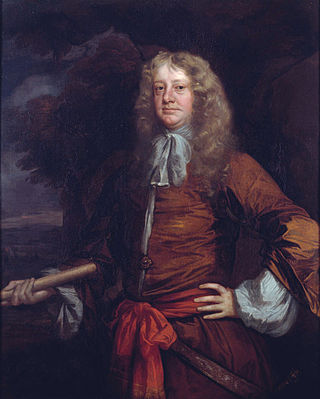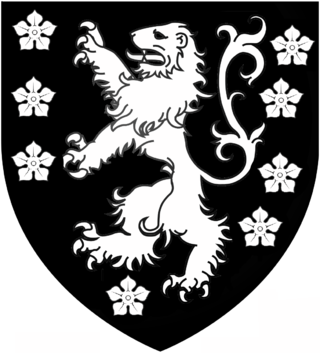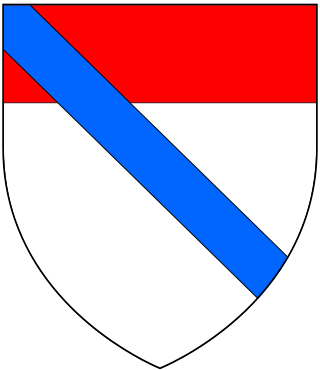Related Research Articles

Admiral Sir George Ayscue was an English naval officer who served in the English Civil War and the Anglo-Dutch Wars who rose to the rank of Admiral of the White. He also served as Governor of Scilly Isles (1647) and Governor of Barbados (1650–1652).

Sir John Gell, 1st Baronet was an English landowner from Derbyshire, who acted as local Parliamentarian commander for most of the First English Civil War before resigning in May 1646. He was notorious for parading the body of his Royalist opponent through Derby after the Battle of Hopton Heath in March 1643.
Philip Stanhope, 1st Earl of Chesterfield was an English nobleman, aristocrat and royalist, who was created the first Earl of Chesterfield by King Charles I in 1628.

Robert Willoughby, 6th Baron Willoughby de Eresby was an English nobleman and military commander in the Hundred Years' War.
Thomas Willoughby, 1st Baron Middleton, was a Tory politician who sat in the English and British House of Commons between 1698 and 1711 when he was raised to the peerage as Baron Middleton as one of Harley's Dozen.

Shelford Priory is a former Augustinian Monastery located in the village of Shelford, Nottinghamshire, United Kingdom. The priory was founded by Ralph Haunselyn around 1160–80 and dissolved in 1536. Little remains of the original priory. Following dissolution it was granted to Michael Stanhope, and c.1600 Shelford Manor was constructed on the site. The manor was fortified and then partially destroyed during the English Civil War. The house was reconstructed c.1678, however, it was altered in the 18th and 19th centuries. It is now known as Shelford Manor and is a private residence.
Sir John Stanhope was an English knight and landowner, and father of Philip Stanhope, 1st Earl of Chesterfield.
Sir Thomas Stanhope was the son and heir of Sir Michael Stanhope, and a Member of Parliament for Nottinghamshire.

Sir Michael Stanhope of Shelford in Nottinghamshire, was an influential courtier who was beheaded on Tower Hill, having been convicted of conspiring to assassinate John Dudley, 1st Duke of Northumberland, and others.

Willoughby on the Wolds is a small village in Nottinghamshire, England, on the border with Leicestershire. Its nearest neighbouring villages are Wysall, Widmerpool, Wymeswold and Keyworth, with the nearest towns and cities being Loughborough, Melton Mowbray, Nottingham and Leicester. According to the 2001 census it had a population of 484, increasing to 572 at the 2011 census.
The Sheriff of Nottinghamshire, Derbyshire and the Royal Forests is a position established by the Normans in England.

Sir Gervase Clifton of Clifton, Nottinghamshire and London was a 15th-century English knight and landowner. He was beheaded after the Battle of Tewkesbury.

Colonel Francis Hacker was an English soldier who fought for Parliament during the English Civil War and one of the Regicides of King Charles I of England.

Ralph de Cromwell, 3rd Baron Cromwell was an English politician and diplomat. A Privy Councillor from 1422, he served as Treasurer of England (1433–1443) and twice as Chamberlain of the Household during the reign of Henry VI.
Sir William Stanhope of Shelford, Nottinghamshire was a politician who was a Member of Parliament (MP) for Nottingham from 1685 to 1687.
Colonel Francis Thornhagh or Thornhaugh (1617–1648) was a hero of the Parliamentarian cause in the English Civil War, an MP of East Retford and High Sheriff of Nottinghamshire, who was killed at the Battle of Preston in 1648.
Michael Stanhope may refer to:
John Thornhagh (1648–1723), of Fenton and Osberton, Nottinghamshire, was an English Whig politician who sat in the English and British House of Commons between 1689 and 1710.

Sir Henry Willoughby was a Knight of the Body to Kings Henry VII and Henry VIII and MGO.
The Storming of Shelford House was a confrontation of the English Civil War that took place from 1 to 3 November 1645. The Parliamentarian force of Colonel-General Sydnam Poyntz attacked the Royalist outpost of Shelford House, which was one of a group of strongholds defending the strategically important town of Newark-on-Trent. The house, owned by Philip Stanhope, 1st Earl of Chesterfield and controlled by his son Sir Philip Stanhope, and made up of mostly Catholic soldiers, was overwhelmed by the Parliamentarian force after calls for submission were turned down by Stanhope. The majority of the defenders were killed in the resulting sack by the Parliamentarians, commanded by Colonel John Hutchinson, and the house was then burned to the ground. Stanhope died soon afterwards from injuries he sustained in the attack.
References
- ↑ "St Mary's and All Saints', Willoughby". Nottinghamshire history.
{{cite web}}: External link in|publisher= - ↑ "Willoughby on the Wolds". Nottinghamshire history. Retrieved 20 May 2009.
- ↑ Fox, J. Charles (2008). Nottinghamshire. Read Books. p. 235. ISBN 978-1-4097-6530-1.